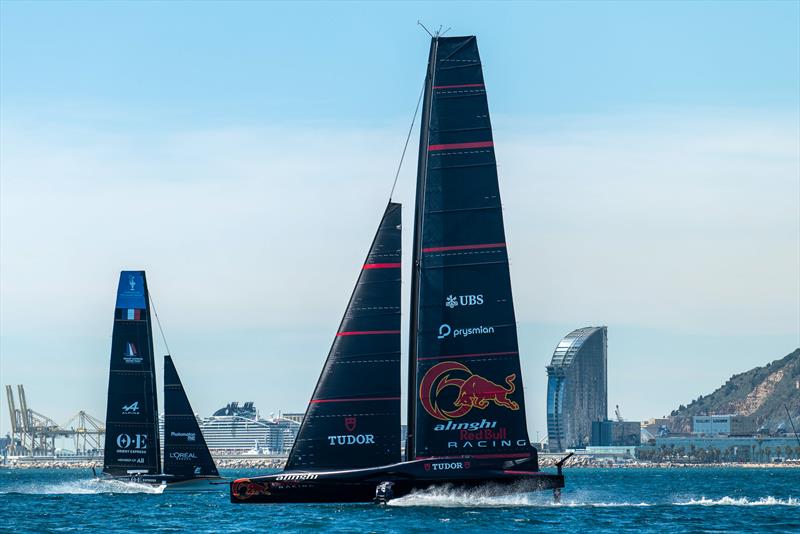
Alinghi Red Bull Racing - AC75 - Day 14 - May 10, 2024 - Barcelona - photo © Paul Todd/America's Cup
Dear Recipient Name
A month ago, when I wrote AC75 launching season, just three of the AC75s set to contest the 37th America's Cup in Barcelona had been revealed. Now it's five, with just the French Orient Express Racing Team left to show their hand.
I have to admit I'm very surprised just how different all the boats are. The hull shapes are wildly varying, with design teams obviously prioritising different aspects as important, and exploring different corners of the AC75 design rules.
I expected the new designs to be refined versions of Emirates Team New Zealand's 36th America's Cup-winning yacht 'Te Rehutai'. Why? Probably an 'if it ain't broke, don't fix it' mentality, but the America's Cup doesn't have that philosophy. The America's Cup is about finding breakthroughs, exploring options, and thinking differently.
It's incredibly hard to cast your eye as a layman on each hull and say, 'That one's right' or 'That one's wrong'. The CFD (computational fluid dynamics) is now absurdly complex; the interactions between hull and air, hull and water, rig and hull, foils and water, rig and air are mind-boggling.
The hull reveals have given us a glimpse of what teams' priorities were going into the design stage, and how they've gone about achieving that. We've also got to see them out on the water and seen how their initial sails have gone. These aren't going to be a measure of eventual speed, but do give an idea of the attitude of the boat in flight, the windward heel, how the rig sets up, how the boat pops out of the water and, maybe crucially, how the boat performs in waves.
So, who's got it right and who's got it wrong? We simply don't know at this stage, and I very much doubt it's as simple as right and wrong. They are so many nuances, so many variables, and so much we can't see on these boats.
The teams are also testing with a combination of previous generation foils and their new designs, often with one of each. This is an area where we can clearly see how things have evolved.
I was taken by a comment from Luna Rossa Prada Pirelli coach, Phillipe Presti, when talking about the new yachts compared to those used in the 36th America's Cup:
"The boats are nothing like what we had last time. This is a new generation of boats and they are way quicker and agile. At the low end we can take off at 6.5 or 6 knots. So, they are really a machine, a wind machine."
There is something I'm already missing on the latest generation of AC75s, and that's crew movement. We literally can't see a thing of what they're up to, apart from the slight bobbing of the cyclors' heads as they generate the power needed to control these foiling leviathans. No-one moves about the boat, no-one pops out of their pod until the boat is stopped.
All we see is the result of their work: The change of course, the slight adjustment of the mainsail and jib, the main foils going up and down and, frankly, not much else. I worry that after the novelty of seeing how these boats perform, and then later how they line up against each other, my interest will wane. Will I watch a full race once I know one boat is faster than another? I guess I won't know until the time comes.
The big element that is missing right now is the people, personalities, and rivalries. We're getting the recon interviews after a training session, with one of the team selected to talk, but these invariably talk about the boats and how the session went. The technology is discussed, but not in too much detail as they don't want to give anything away. It results in the interviewee being guarded, and with it, their personality shrouded.
Come competition, hopefully we'll see the characters of Peter Burling, Nathan Outteridge, Tom Slingsby, Paul Goodison, Ben Ainslie, Giles Scott, Francesco Bruni, Ruggero Tita, Arnaud Psarofaghis, Nicolas Charbonnier, Quentin Delapierre and Kevin Peponnet brought to the fore. The technology is interesting, but it's the rivalries that will make the event engrossing.
Let's hope that every team has got something right and something wrong, or just found a different way of making a fast AC75. If that's the case we'll have times when each team flourishes, and the potential for a close selection series in the Louis Vuitton Cup and America's Cup match.
The holy grail for the event is tight racing. We saw it at times in Auckland during the 36th America's Cup, with place-changing aplenty and match-racing manoeuvres in play. In these situations, the link-up between the two sides of the boat, where each helmsman takes turns on the wheel, is going to have to be almost symbiotic. Decisions are often made in the blink of an eye, and the other helmsman is going to have to understand exactly what is happening faster than it can be explained to them.
This brings up the question of have they had enough recent match racing experience? Should the sailors have also been competing on the World Match Racing Tour to keep their hand in at the craft? It's going to be fascinating to watch it all play out.
Mark Jardine
Sail-World.com and YachtsandYachting.com Managing Editor
|